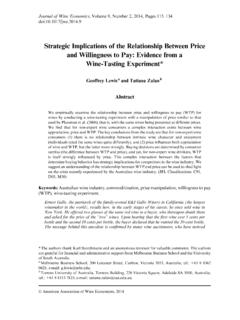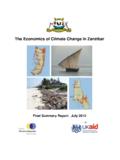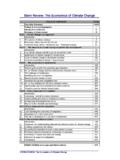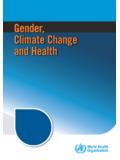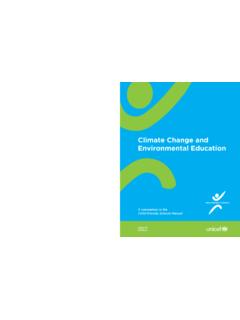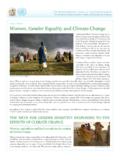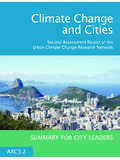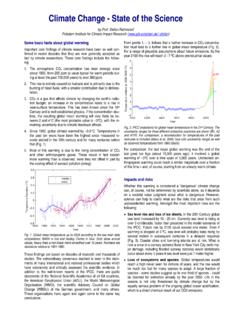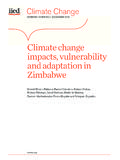Transcription of The Impact of Climate Change on Viticulture and …
1 Journal of Wine Economics, Volume 11, Number 1, 2016, Pages 150 167. The Impact of Climate Change on Viticulture and Wine Quality*. Cornelis van Leeuwen a and Philippe Darriet b Abstract Climate Change is a major challenge in wine production. Temperatures are increasing world- wide, and most regions are exposed to water de cits more frequently. Higher temperatures trigger advanced phenology. This shifts the ripening phase to warmer periods in the summer, which will affect grape composition, in particular with respect to aroma compounds. Increased water stress reduces yields and modi es fruit composition.
2 The frequency of extreme climatic events (hail, ooding) is likely to increase. Depending on the region and the amount of Change , this may have positive or negative implications on wine quality. Adaptation strategies are needed to continue to produce high-quality wines and to preserve their typicity according to their origin in a changing Climate . The choice of plant material is a valuable resource to implement these strategies. (JEL Classi cations: Q13, Q54). Keywords: Climate Change , temperature, water de cit, wine quality, wine typicity. I. Introduction The reality of Climate Change is admitted by the vast majority of the scienti c community (IPCC, 2014).
3 Among human activities, agriculture in particular Viticulture is highly dependent upon climatic conditions during the growing season. Hence, wine production is obviously affected by Climate Change . Return on investment in most agricultural production is driven by yield, thus it is relevant to study the Impact of Climate Change on yield parameters. Return on investment in wine production is driven as much by sales prices, based on quality and reputa- tion, as by yield. In Viticulture , it is thus important to study the implications of *. We thank Marc and Matthieu Dubernet for the data on grape composition in the Languedoc (Figure 2).
4 And Alexandre Pons for the massoia lactone data (Figure 4). a Bordeaux Sciences Agro, ISVV, UMR Ecophysiologie et G nomique Fonctionnelle de la Vigne n 1287, F-33140 Villenave d'Ornon, France; e-mail: (corresponding author). b Universit de Bordeaux, Unit de recherche nologie, ESC 1366 INRA, ISVV, F-33140 Villenave d'Ornon, France; e-mail: American Association of Wine Economists, 2016. Cornelis van Leeuwen and Philippe Darriet 151. Climate Change not only on yield but also on quality ( , Ashenfelter and Storchmann, 2016; Oczkowski, 2016). In this paper, we address the Impact of Climate Change on vine phenology and development, grape and wine composition, and wine typicity according to origin.
5 Some of these changes have already occurred and can be quanti ed; others are predictable in the coming decades. II. The Effect of Climate on Wine Production Climate is a major factor in wine production. In the scienti c literature, many papers address the effect of Climate . Vines are grown in a wide variety of climatic situations. However, a majority of the major wine-growing regions are located between the 35th and the 50th parallels in the Northern Hemisphere and between the 30th and the 45th parallels in the Southern Hemisphere. It is virtually impossible to produce high-quality wines in tropical or subtropical regions.
6 Wine growing is also complicat- ed at high latitudes because of injury caused by spring or winter frost and because of a loss of bud fertility at low temperatures. Each of the main wine-producing regions can be characterized by mean climatic conditions, which are well described in Gladstones (2011). These climatic conditions are a major driver of wine typicity in relation to its origin (van Leeuwen and Seguin, 2006). Among environmental factors, Climate has a greater Impact on vine development and fruit composition compared to soil and grapevine variety (van Leeuwen et al.)
7 , 2004). In a given wine-producing region, climatic conditions vary from one year to the other. These variations induce the vintage effect, year-to-year variations in yield, quality, and typicity. Growers have chosen plant materials (variety, clone, and rootstock) accord- ing to local climatic conditions in order to optimize the compromise between yield and quality. Viticultural practices can be modi ed to adapt to climatic variability among vintages. A. Temperatures Vine phenology that is, the date on which bud break, owering, and v raison (onset of ripening) occur is driven by temperature.
8 This relation is so strong that vine phenology can be predicted by models that are based only on temperature (Parker et al., 2011). Temperature also affects fruit ripening. Sugar accumulation in- creases with temperature (Coombe, 1987), but certain secondary metabolites, like anthocyanins, are negatively affected by high temperature (Kliewer and Torres, 1972). Grape acidity, in particular the malic acid content, decreases in high temper- ature (Coombe, 1987). B. Water Status Vine water status depends on soil texture, percentage of stones, rooting depth, rain- fall, reference evapotranspiration (ET0), and leaf area.
9 Water de cit impairs 152 The Impact of Climate Change on Viticulture and Wine Quality photosynthesis (Hsiao, 1973), and shoot growth (Lebon et al., 2006) and reduces berry size (Tr goat et al., 2002; van Leeuwen and Seguin, 1994). It increases grape tannin and anthocyanin content (Duteau et al., 1981; Matthews and Anderson, 1988; van Leeuwen and Seguin, 1994). Excessive water de cit stress can lead to damage on leaves and stuck grape ripening. C. Radiation As long as water is not a limiting factor, vine photosynthesis increases with light in- tensity until one-third of maximal radiation and then levels off (Kriedemann and Smart, 1971).
10 Contradictory results have been published on the Impact of light on grape phenolics, probably because it is dif cult to separate the effect of light from that of temperature. In a eld study with an adapted experimental design, Spayd et al. (2002) showed that the amount of anthocyanin in grape skins increases with light but is negatively affected by high temperature. III. Climate Change Most scientists have admitted the reality of Climate Change , caused by human activ- ities and in particular the emission of greenhouse gases, since the 1990s. The main measurable effect of Climate Change is a steady increase in temperature.
